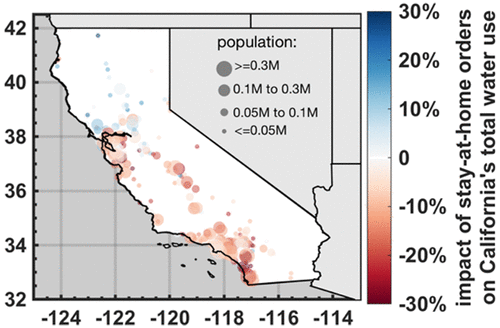当前位置:
X-MOL 学术
›
Environ. Sci. Technol. Lett.
›
论文详情
Our official English website, www.x-mol.net, welcomes your
feedback! (Note: you will need to create a separate account there.)
Stay-at-Home Orders during the COVID-19 Pandemic Reduced Urban Water Use
Environmental Science & Technology Letters ( IF 8.9 ) Pub Date : 2021-02-10 , DOI: 10.1021/acs.estlett.0c00979 Dongyue Li 1, 2 , Ruth A Engel 1 , Xiaoyu Ma 1 , Erik Porse 3, 4 , Jonathan D Kaplan 5 , Steven A Margulis 2 , Dennis P Lettenmaier 1, 4
Environmental Science & Technology Letters ( IF 8.9 ) Pub Date : 2021-02-10 , DOI: 10.1021/acs.estlett.0c00979 Dongyue Li 1, 2 , Ruth A Engel 1 , Xiaoyu Ma 1 , Erik Porse 3, 4 , Jonathan D Kaplan 5 , Steven A Margulis 2 , Dennis P Lettenmaier 1, 4
Affiliation

|
In response to the outbreak of the COVID-19 pandemic, many governments instituted “stay-at-home” orders to prevent the spread of the coronavirus. The resulting changes in work and life routines had the potential to substantially perturb typical patterns of urban water use. We present here an analysis of how these pandemic responses affected California’s urban water consumption. Using water demand modeling that fuses an integrated water use database, we first simulated the water use in a business-as-usual (non-pandemic) scenario for essentially all urban areas in California. We then subtracted the business-as-usual water use from the actual use to isolate the changes caused solely by the pandemic response. We found that the pandemic response decreased California’s urban water use by 7.9%, which can be largely attributed to an 11.2% decrease in the commercial, industrial, and institutional sector that more than offset a 1.4% increase in the residential sector. The influence of the stay-at-home practices on urban water use is slightly stronger than the combined influences of all non-pandemic factors. This study covers both metropolitans and suburbs; therefore, the results could also be useful for analysis of the impacts of COVID-19 on water use in other urban areas.
中文翻译:

COVID-19 大流行期间的居家令减少了城市用水量
为了应对 COVID-19 大流行的爆发,许多政府制定了“呆在家里”的命令,以防止冠状病毒的传播。由此产生的工作和生活习惯的变化有可能严重扰乱城市用水的典型模式。我们在此分析这些大流行应对措施如何影响加州的城市用水量。使用融合了综合用水数据库的用水需求模型,我们首先模拟了加州几乎所有城市地区照常(非大流行)情景下的用水情况。然后,我们从实际用水量中减去正常用水量,以隔离仅由大流行应对措施引起的变化。我们发现,疫情应对措施使加州城市用水量减少了 7.9%,这在很大程度上归因于商业、工业和机构部门用水量减少了 11.2%,这远远抵消了住宅用水量 1.4% 的增长。居家隔离对城市用水的影响略强于所有非疫情因素的综合影响。这项研究涵盖了大都市和郊区;因此,研究结果也可用于分析 COVID-19 对其他城市地区用水的影响。
更新日期:2021-02-10
中文翻译:

COVID-19 大流行期间的居家令减少了城市用水量
为了应对 COVID-19 大流行的爆发,许多政府制定了“呆在家里”的命令,以防止冠状病毒的传播。由此产生的工作和生活习惯的变化有可能严重扰乱城市用水的典型模式。我们在此分析这些大流行应对措施如何影响加州的城市用水量。使用融合了综合用水数据库的用水需求模型,我们首先模拟了加州几乎所有城市地区照常(非大流行)情景下的用水情况。然后,我们从实际用水量中减去正常用水量,以隔离仅由大流行应对措施引起的变化。我们发现,疫情应对措施使加州城市用水量减少了 7.9%,这在很大程度上归因于商业、工业和机构部门用水量减少了 11.2%,这远远抵消了住宅用水量 1.4% 的增长。居家隔离对城市用水的影响略强于所有非疫情因素的综合影响。这项研究涵盖了大都市和郊区;因此,研究结果也可用于分析 COVID-19 对其他城市地区用水的影响。











































 京公网安备 11010802027423号
京公网安备 11010802027423号